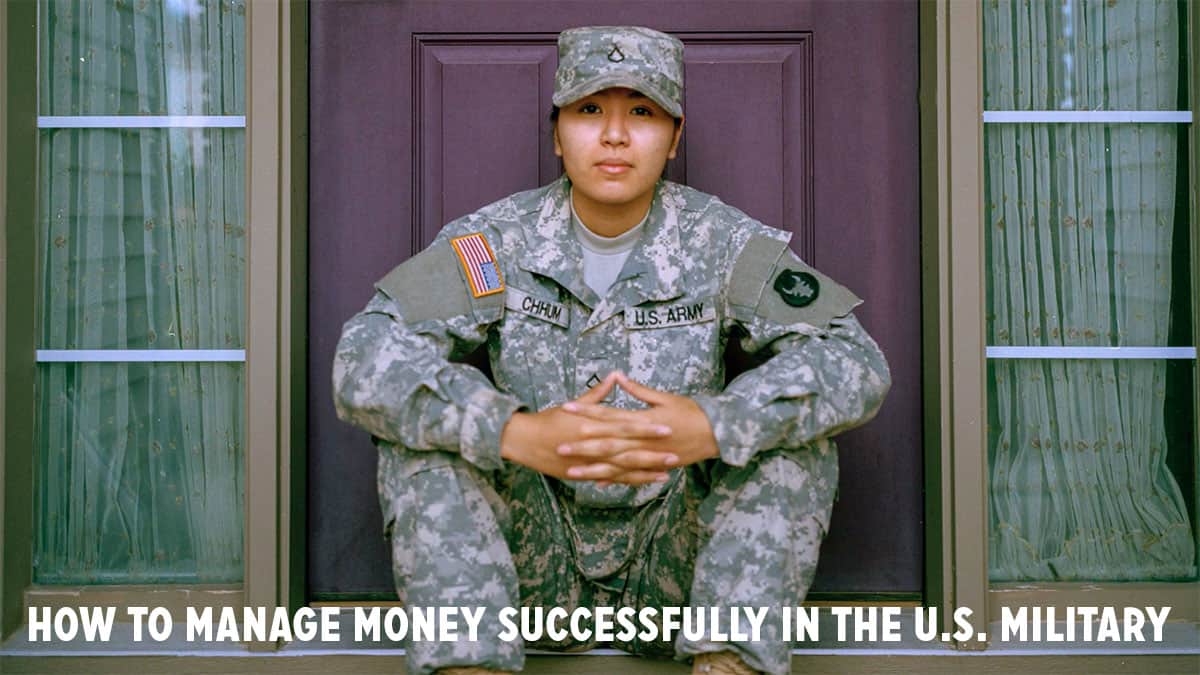How to manage money for financial success in the U.S. military

Howdy! I’m Spencer, an active-duty Air Force officer investing for financial independence by age 40. Since 2016, my wife and I have saved half of my active-duty paycheck into our financial independence accounts. I started writing in 2012 about achieving FI in the military on my website Military Money Manual.
Because J.D. has no experience with the military, for Veterans Day he asked me to share the lessons I think every servicemember needs to know about getting rich slowly. These are the concepts I wish someone had explained to me as a newly-commissioned officer in 2010. (These lessons are just as applicable to the enlisted side of the house.)
I’ve split this article into two sections.
First, I’ll cover some basic lessons for beginners: taking care of yourself, emergency funds, military friendly banks, tracking your money, and TSP investing.
Next, I’ll cover some advanced topics: investing for financial independence, military deployment, travel, and military credit-card perks.
Let’s start with the basics.

Educate Yourself
One of the harshest life lessons you must learn early in your military career is this: “No one is looking out for you except you.”
You must take responsibility to educate yourself about saving, investing, spending, and achieving financial independence. If you have a really good supervisor or commander in the military, they may explain the Thrift Savings Plan (TSP) to you, but that’s probably it.
If you want to achieve financial independence in the military, you need to learn how to do it yourself. There are many resources available to learn about money, including:
- /r/MilitaryFinance on Reddit
- /r/personalfinance on Reddit
- The military finances page at the Bogleheads wiki
- Any of the books on my recommended reading list (or J.D.’s list)
I believe it’s important to always be learning, to always be asking questions. If you have questions about your military pay, benefits, or personal finance, type them into Google. Ask your supervisor. Ask your buddies (but don’t always take their advice haha).
Never be afraid to ask questions. Keep yourself educated about money.
Find a Military-Friendly Bank
While you can certainly use a regular bank to manage your money (and Get Rich Slowly maintains a list of online savings accounts), I recommend finding a military-friendly bank. Certain banks and credit unions are dedicated to helping military service members. They understand the difficulties unique to our situation. For instance, USAA has never shut down my ATM card despite withdrawals in over 40 countries.
Some of the largest and most recognized military-friendly banks include USAA, Pentagon Federal Credit Union (PenFed), and Navy Federal Credit Union (NFCU).
Look for a military-friendly bank that offers ATM fee reimbursement and that doesn’t charge fees on your accounts no matter what your balances are. Many military-friendly banks will deposit your military pay one business day earlier than your actual payday. This is a nice feature to get access to your money a little earlier each payday.
Build an Emergency Fund
Unlike your civilian counterparts, you’re unlikely to be suddenly fired from the military. Because it’s a government job, you would at least get a few months notice if you were involuntarily separated.
You also don’t have to worry too much about surprise medical bills. Tricare is one of the best healthcare insurance networks in the U.S., and the military medical system is one of the most affordable. You will rarely, if ever, have a co-pay to see a doctor or pick up a prescription.
So, if you don’t have to worry about medical expenses or getting fired, why worry about saving an emergency fund in the military? Because things always go wrong.: cars break, payment of travel vouchers is delayed, the government shuts down, and so on.
Plus, you know how unpredictable military service can be. You may be called away suddenly for a contingency operation in Africa when the car breaks down at home, preventing your husband from getting to work.
Many times when you receive PCS (permanent change of station) or go TDY (temporary duty assignment), your expenses won’t be immediately reimbursed. If you have an incompetent finance office, it may be weeks or months before you finally get paid for that trip.
When you have an emergency fund, you can cover these expenses and not sweat it while finance gets their act together.
When the government shut down in early 2019, members of the Coast Guard went unpaid for an entire pay period. This was an extremely stressful time for many folks. You can insure yourself against political theatrics like this by having an emergency fund.
How big should your emergency fund be? I recommend starting with $1000 and then saving up so that you have enough to cover six months of expenses.
Personally, as an eight-year captain, I have $10,000 in my emergency fund. This isn’t six months of expenses, I admit, but it will cover two plane tickets to fly me and my wife home in case we need to be with family in an emergency. And $10,000 will cover all but the most serious car repairs. It’s the amount that lets me sleep easy at night.
Know Where Your Money Goes
Trust me, I hate budgeting. But if you want to achieve financial success — in the military or otherwise — it’s important to understand where your money is going. This helps you determine if you have optimized your spending to make you happy.
Here’s an example: Let’s say you notice you’re spending $100/week on Buffalo Wild Wings. But you don’t even like wings and beer that much. And you’re trying to lose weight. Well, it looks like you found a great expenditure to eliminate! Most of us can find spending like this to trim from our budgets.
To make tracking easier, I recommend apps like You Need a Budget (YNAB), Personal Capital, or Mint. Or, if you like computers, track your money in a simple spreadsheet.
The key is to make sure that your spending aligns with your goals, that you’re happy with what you’re spending money on.
As for me, I hate budgeting, as I said. After I trimmed the obvious fat from my spending, I adopted what I call an “anti-budget”. I save half of my income into my investment accounts (TSP, IRA, taxable brokerage, and cash accounts). I spend the rest of my money and don’t worry about it. This system is simple. For me, simple is best.
I don’t enjoy analyzing my budget, so I make sure the big three expenses — housing, transportation, and food — are correct, then I live my life. If you get these three right, you can take care of 80% of your savings for only 20% of the effort.
Get Your Full TSP Match
The military’s version of a 401(k) is called the Thrift Savings Plan, or TSP. It’s a boring name that doesn’t really sell the fact that it’s one of the best retirement plans available in the world.
The TSP offers five funds, which together make up most of the investable assets in the world. These funds are:
- C Fund: contains the S&P 500 companies, the largest 500 companies in America
- S Fund: contains the 3529 publicly-traded companies in America that aren’t in the S&P 500
- I Fund: an international stock fund covering 21 nations outside the U.S.
- F Fund: a fixed-income fund that invests in corporate bonds
- G Fund: the government bond fund
In addition to these five funds, you can also invest in TSP Lifecycle funds. These are target-date retirement funds that automatically adjust their mix of stocks and bonds over time. In theory, they deliver higher returns with more volatility early in your career, then they become more bond heavy as you age.
The TSP expense ratios are famously low, usually around 0.04% annually. That means for every $1000 you invest in the TSP, you pay $0.40 per year in management fees. That’s it! (And that’s amazing.)
Even on a $1,000,000 portfolio you’d pay only $400 per year. These fees are some of the lowest available in any retirement plan.
You can contribute up to $19,000 into the TSP in 2019. If you deploy to a combat zone, you can contribute up to $56,000.
The TSP is an employer-sponsored retirement plan, so it’s completely separate from your IRAs, or Individual Retirement Accounts. That means you can put $19,000 into your Roth TSP and $6000 in your Roth IRA — $25,000 total for a year!
If you could contribute $25,000 to your IRA and TSP for a full 20-year military service, you’d have $1,100,000 after 20 years, assuming a 7% return. If you entered military service at age 20, retired at 40, and left the $1,100,000 to grow until age 60 at 7%, you’d have $4.2 million. That’s the power of compounding and paying yourself first!
If you joined the military after 2017, you’re automatically in the Blended Retirement System (BRS). In order to maximize your retirement savings, you must contribute at least 5% of your base pay every month.
The government automatically contributes 1% of your base pay to your Traditional TSP account on your behalf. They will contribute up to another 4% if you contribute 5%. This 5% can be worth thousands of dollars annually.
When you retire, that 5% match could have grown to tens of thousands (or hundreds of thousands) of dollars.
One of my biggest financial regrets it not contributing to my Thrift Savings Plan earlier. Especially now that you can receive a match on your contributions, you need to at least contribute 5% monthly to your TSP as soon as you commission or graduate basic training.
Okay, now that we’ve covered some basic military money topics, let’s move on to some more advanced material.
Use Credit Wisely
There are a lot of folks who believe credit cards are evil. And if you’re not careful, you can end up deep in debt. Many military members do so. But if you understand how to use credit cards wisely, they can be an excellent tool to help you achieve financial success.
Servicemembers have two laws working in their favor: the Military Lending Act (MLA) and the Servicemembers Civil Relief Act (SCRA).
These laws have been generously interpreted by most of the major credit-card companies, including American Express and Chase. Both companies are waiving annual fees for servicemembers for cards opened after entering active duty status.
The American Express SCRA policy goes beyond the legal requirements. AMEX waives all annual fees for active-duty servicemembers, Title 10 Reservists, and Title 32 National Guard. This includes their civilian spouses, usually as long as the servicemember is added as an authorized user to the account.
The AMEX SCRA policy applies to both personal and business cards. For instance, my wife and I currently have 13 AMEX cards with $4665 of annual fees waived. The annual recurring benefits of these free cards include:
- Three free nights at Marriott with Gold Elite status
- $600 Marriott expenses credit
- One free night at Hilton with Diamond Status
- $250 Hilton Resort credit
- $1150 in airline fee credits reimbursed
- $800 of Uber or Uber Eats credit
- Companion pass in Delta first class
These benefits add up quickly: airport lounge access, upgrades to business class, free hotel stays, and free food really goes a long way to making travel free or very cheap.
Since 20 Sep 2017, the Chase MLA policy waives all annual fees on their personal (not business) credit cards for military servicemembers and their spouses. This includes active duty, Title 10 reservists, and Title 32 Guard.
This includes their Chase Sapphire Reserve card, which comes with an annual $300 travel credit good towards airfare, hotels, taxis, trains, Uber, rental cars, parking, and anything else travel related. Chase waives the $450 annual fee on this card for both military servicemembers and their spouses.
These are just some of the credit card benefits extended exclusively to US military personnel. I keep a page updated with the best credit cards for military troops.
But again: Credit cards are only useful and valuable if you don’t carry a balance. If they’re going to lead you into debt, you should avoid them. The bonuses and perks aren’t worth the cost of debt.
Deal with Deployment
Believe it or not, deployment is a golden opportunity to put yourself way ahead – smash debt, save a ton, spend nothing, and figure out what you want to do with your life.
The biggest financial advantages to a military deployment are:
- Tax-free combat zone income (CZTE)
- Tax-free contributions to your Roth TSP and Roth IRA
- Savings Deposit Program (SDP)
Combat zone tax exclusions, or CZTE, are available when you are in a Presidential-declared and IRS-recognized designated combat zone for at least one day of any month. So even if you just fly in, land, and take off again two hours later, you’re eligible for CZTE pay that month.
Your pay during any CZTE month will not be subject to federal income tax. It is subject to FICA tax, so you’ll see Social Security and Medicare tax deducted from your paycheck.
Because your income is tax free any month you’re in a combat zone, you have a unique opportunity to get tax-free money into your Roth IRA and Roth TSP. The money goes in untaxed, grows untaxed, and can come out untaxed, subject to the rules of Roth accounts!
This triple no-tax win is an amazing investment opportunity almost no one else in America can access.
Another program available to you on deployment is the Savings Deposit Program or SDP. The SDP offers a guaranteed 10% return on your investment on up to $10,000 invested.
For example, if you’re on a one-year deployment and invest $10,000 from the beginning of the deployment, you could earn $1000 by the time you head home.
While you’re deployed, your expenses can drop to nearly zero, depending on how much family you’re supporting back home. All the essentials — like food, housing, a gym, and transportation — are covered. You just need to work, work out, eat, and sleep.
Your income will also increase due to the CZTE pay, hardship duty pay, family separation pay, hazardous duty pay, hostile fire pay, and many other special payments you can receive while deployed.
The combination of low expenses and high income means you can really set yourself up for financial success. On my first deployment, I paid off my USAA cadet loan. After my third deployment, I finished paying off my student loans.
If you don’t have any debt, use a deployment to max out your retirement accounts, max out the SDP, and save some money for whatever your future goals are. Set an outrageous goal for yourself, like saving $50,000 in six months. I’ll bet you’ll surprise yourself with how much you can save on a deployment!
Don’t forget to set aside a little money to enjoy life when you get back to the real world. Military deployments aren’t vacations and they’re not stress free. Make sure you take some of your deployment savings to visit your loved ones or take your family skiing.
Travel for Free (or Cheap)
Going TDY (temporary duty) can be a great way to travel and make extra money while you serve. When you’re sent away from your permanent duty station (PDS) on official business, you’ll receive per diem to offset your increased expenses.
Lodging expenses are reimbursed at the rate they were paid. If your authorized lodging amount was $200 and your hotel was $150 per night, you are reimbursed $150. You do not keep the difference.
On the other hand, your meals and incidental expenses (or M&IE) are paid regardless of expenses incurred. If you’re authorized $100 per day and you grab breakfast at the hotel, lunch at Chick-Fil-A for $10, and dinner at Chipotle for $15, you get to keep the remaining $75 per day.
Per diem can add up quickly, especially if you’re on a long training TDY. It can also disappear quickly — usually on drinks out with your coworkers. Be smart about it.
Leave in conjunction with official travel (LICWO) and circuitous travel during PCS are excellent ways to travel to new destinations and get reimbursed for your travel. Essentially, you can take the scenic route to get to your next duty station or temporary assignment.
The government will reimburse you up to what they would have paid for a ticket. Since the government almost always buys full fare, full flexible economy tickets, you can usually get much cheaper flights and get some free travel in during your leave. Here are more details and nuances of LICWO and circuitous travel.
Space Available (Space-A) travel is a tremendous benefit available to servicemembers. Usually if there is an empty seat on a military flight, the passenger terminal will open it up to servicemembers and dependents. Free travel around the world!
There are a lot of caveats to Space-A, and it’s not a very reliable or seamless process all of the time. I recommend that you check out SpaceA.net and their Facebook group for the best information on travelling Space-A.
Invest for Financial Independence
Most servicemembers don’t make it to 20 years of service. The figures vary by service and officer vs. enlisted, but only about 20% of servicemembers who serve earn any kind of military pension, whether it’s active duty, guard, or reserve.
But even without a pension, military service can set you on the path to financial independence (FI). The military can teach you discipline, goal setting, and perseverance. All of these traits are useful if you want to complete a multi-year project like investing for financial independence or early retirement.
Military servicemembers have unique investment opportunities available to them that civilians do not. (We’ve already covered some of these, such as the TSP, SDP, and tax-free income.) However, the principles of FI apply to military servicemembers the same as civilians.
Achieving financial freedom in the military is simple, but not easy:
- Save and invest enough of your money until you have 25x your annual expenses invested in low-cost, total stock and bond market index funds.
- Now you can safely withdraw 4% of your invested assets annually to pay for your living expenses.
- Voila, you don’t need to work anymore!
As I say, the concept is simple — but it’s not easy to achieve. How quickly you can achieve 25x of your expenses depends primarily on your saving rate.
- Save 10% a year and you’ll achieve financial freedom in 51 years.
- Save 25% and you cut it down to 32 years.
- Save 50% and you are looking at only 17 years of investing to achieve financial independence.
Seventeen years is less time than it takes to earn a military retirement pension! Combine a military pension with FI and you’re looking at a fat retirement.
Or, if you don’t make it to 20 years (like 80% of your brothers and sisters in arms), you can still achieve FI by combining your military savings with whatever your post-military plans are.
Conclusion
I hope this was a valuable introduction to military finances. Armed with these lessons, I believe that every single servicemember can achieve financial success during and after their military career.
And remember: Most advice that applies to civilians applies just the same to military folks. It ultimately comes down to: “spend less than you earn and invest the difference”. That’s all it takes to eventually become financially independent. How long that takes is up to you!
Become A Money Boss And Join 15,000 Others
Subscribe to the GRS Insider (FREE) and we’ll give you a copy of the Money Boss Manifesto (also FREE)

